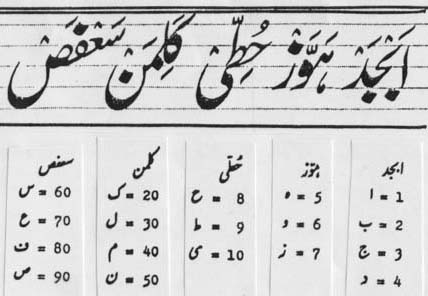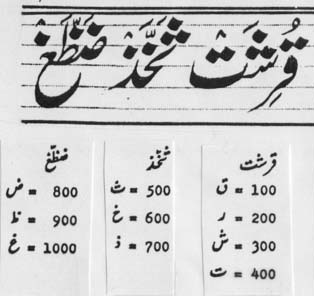Section 13 == *script chart*; *positional chart*; *more help*


The script part is from a manual of calligraphy, the rest a xerox-and-cut-and-paste job from Narang's reader.
"Abjad" is the name given to the arrangement of the Arabic alphabet according to the occurrence of its 28 letters in a series of eight symbolic "words" (shown above), the first of which is "abjad" itself. (People used to memorize these "words," horribly clunky as they are, in order to have a quick key to the system.) Every letter has a numeric value in this arrangement, and can thus be used for composing taari;x , or chronograms. The order of the eight words and the numerical values of the letters are given above.
For printing convenience, here is a *single PDF page with the above numerical chart*.
The abjad system permits words and letters to encode dates. Dates are always understood to be those of the ;hijrii dating system, which uses lunar years starting from 622 A.D. when the Prophet left Mecca and took refuge in Medina. The system assigns to the twenty-eight letters of the Arabic alphabet the numerical values shown above.
Since the official list includes only the original letters of the Arabic script, the later-added Persian and Urdu letters are analogized: for example, gaaf is treated like kaaf . Here's the full set of equivalences:
pe is valued as be
;Te is valued as te
che is valued as jiim
;Daal is valued as daal
;Re is valued as re
zhe is valued as ze
gaaf is valued as kaaf
ba;Rii ye is valued as chho;Tii ye
Arabic al
constructions go by script, not sound
a tashdiid creates a full
additional letter
The point of the system is to permit one to make chronograms, words or phrases such that the abjad value of their letters adds up to some important date to be remembered. Book titles were often made to encode the year of the book’s composition; expressions recording grief at the death of so-and-so were made to encode the year of the death; praise of a king’s military prowess were made to encode the year of some notable conquest. Chronograms are still made today among Urduu-knowers. To compose a chronograh is taari;x kahnaa ; the whole art itself is known as fann-e taari;x . The word taari;x itself is also used to mean both "history" and "date."
13.2 = examples of taarii;x composition
Some poets were exceptionally good at this art, and their skills were much in demand among their friends; Azad's *aab-e ;hayaat* (1880) and other such works are full of examples. Here are a few examples for practice.
Example one: Ghalib composed a chronogram for his own death: ;Gaalib murd , "Ghalib died." The phrase stands for the year 1277 A.H. (1860/1), which is worked out as follows, for a total of 1277:
| ;Gain
= 1000 alif = 1 laam = 30 be = 2 |
miim
= 40 re = 200 daal = 4 |
(As it turned out, Ghalib didn't die in that year; he later joked about this fact in his letters. Azad's account of this: Pritchett and Faruqi, p. 510)
Example two: "786" is used by many Muslims as a numerical code for baa ism ul-l;aah ul-ra;hm;aan ul-ra;hiim . Note: the "dagger alif " letters don't count.
| be = 2 siin = 60 miim = 40 alif = 1 laam = 30 laam = 30 he = 5 |
alif = 1 laam = 30 re = 200 ba;Rii ;he = 8 miim = 40 nuun = 50 |
alif = 1 laam = 30 re = 200 ba;Rii ;he = 8 chho;Tii ye = 10 miim = 40 |
| 168 | 329 | 289 |
(In case you find this example unusually difficult to work through, you're not alone. I never could have made it come out right without the help of my students.)
Example three: From Ralph Russell and Khurshidul Islam, Ghalib: Life and Letters (Cambridge: Harvard University Press, 1969), p. 247:
"Perhaps the best chronogram which Ghalib composed himself was that on the Mutiny-- rustkhez-i beja-- which he worked out and included in Dastambu.... The phrase is indeed an apt one, for it both fixes the date of the Mutiny and expresses Ghalib's view of it. It is not easy to translate. 'Unseasonable tumult' is an approximate equivalent, but 'unseasonable' does not convey the sense of outrage which 'beja' here carries. The other word, 'rustkhez', means 'Judgement Day', but is also used to describe any great tumult or upheaval, including emotional tumult.... If one adds up the numerical values of the letters of the word 'rustkhez' as written in the Urdu script, they give a total of 1277. From these must be deducted the combined values of the two letters 'ja'--for 'beja' may be read as a single word (and, indeed, must be so read to give the meaning required), or alternatively as two words 'be ja', meaning 'without (or, minus) ja'. The total of 'ja' is 4, and 1277 minus 4 comes to 1273, which gives the date of the Mutiny [of 1857] in the Muslim era."
In short, the analysis would look like this:
| re
= 200 siin = 60 te = 400 ;xe = 600 ye = 10 ze = 7 |
jiim
= 3 alif = 1 |
| 1277 | - 4 |
Many chronograms used to be made in ways that were tricky like this, or sometimes even more convoluted. Here's another tricky example from Ghalib: {202,9}. You'll find lots more examples in aab-e ;hayaat .
Example four: The chronogram title of Mir Amman's famous Fort William College version of "Story of the Four Dervishes" is baa;G-o-bahaar ("Garden and Spring"); this title adds up to 1217 AH (1802/3), and thus encodes the year of composition. Try adding it up and see.
Example
five: It's
quite possible to do chronograms in Persian or Arabic,
even if you don't know the languages. According to
Bada'uni's munta;xab ul-tavaarii;x
(in Ranking's translation, vol. 1, p. 601), a poet
called Kahi composed a Persian chronogram that gave the
year of Humayun's death: 'Humayun Padshah fell from the
roof', or humaayuun paadshaah az bam
uftaad . See if you can make it yield 962 A.H.
(1554/5). (With thanks to Joel Lee for providing this
one.)
Example six:
A chronogram composed by Nasikh on Jur'at's death, as
given in *Ab-e
hayat* is as follows: haa))e
hinduustaan kaa shaa((ir mu))aa . It's pretty
straightforward, with the words yielding totals of 16 +
576 + 21 + 571 + 41, adding up to 1225, which
corresponds to 1810-11. Notice that the vaa))o in mu))aa
must be treated as a chair for a hamzah
(as is the case with hu))aa ).
Various small complexities like this must be allowed
for. But in practice, as a student one is usually
recapturing an already-known date, so it's possible to
work backwards from the desired figure and thus become
familiar with the subtleties of the system. (This
example is dedicated to my class of spring 2012.)
If you'd like to explore the
abjad system a bit more deeply, see also: Mehr Afshan Farooqi, "The Secret of
Letters: Chronograms in Urdu Literary Culture," in
Edebiyat 13,2 (2003), pp. 147-58: *this article* is available here
through the kind permission of the author.
And if you'd like to see some
examples of the system in action during its heyday,
here's a translation and analysis of *the inscriptions
on Amir Khusrau's tomb*, which are full of
chronograms.
And here is a "chronogram calculator" available through the websites of its two authors, *David Boyk* and *Daniel Majchrowicz*.
